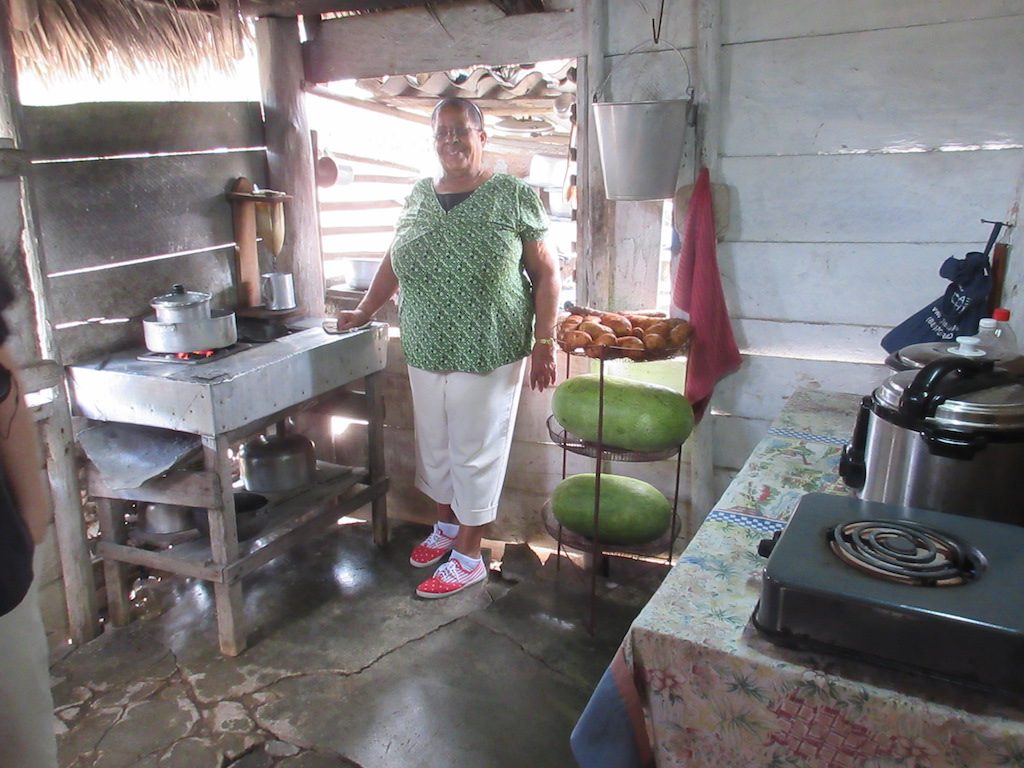Our first stop on this morning was at the Camaguey Ballet rehearsal halls located on a huge estate property. The ballet school is more than 50 years old and is government funded with a troop of about 40 dancers. The ballet company performs all over the nation and has toured all over the world, although not in the U.S. There are two large dance halls with tons of windows but no air conditioning. One room is for the male dancers and one for the female dancers who train five days a week and eight hours a day. They are paid by the government between 250 and 690 Cuban pesos a month, or the equivalent of $10 to $25 a month U.S. We were also able to visit the in-house shoe shop where a crew of workers makes all of the required dance shoes for the the dance troop. They are able to make them for less money than they can buy them and the quality is better. As much as these dancers perform and train they go through a pair of shoes every couple of weeks.
After a comfort stop at the local international airport we drove for about 75 minutes to the King Ranch, a 40,000 acre cattle ranch. The ranch was once privately owned by Americans, but today is owned by the Cuban government. Only about 3,000 acres of the ranch is currently being used to raise cattle by a staff of about 200 ranch hands and cowboys. Due to the local drought and the lack of use of the land much of it has now been grown over by Maribu wood. This tree grows very quickly, is dense and is difficult to control. They have found that if you fence small areas of cleared land and stock it with cattle and goats that before long the goats will have continued to eat the Maribu trees’ new growth until it kills them. This is how they eliminate the Maribu.
The cowboys performed a rodeo show for us with tasks like bull riding and cattle roping. We then took horse drawn buggies a short distance to the local Cafetal village where about 200 residents live and many of the men work on the ranch. We took some school supplies, tooth paste, soaps and shampoo to the local elementary school to be distributed to the students in need. From there we toured one of the local’s home which was very primitive. They did have a concrete floor although it was cracked in multiple places. The walls were made of nothing more than a few boards covered with siding that was very worn, full of rot and falling apart so much that you could see through the walls. There were no windows but only slats of wood that gave some privacy while still allowing the air to flow through the home. The roof was made of palm fronds, but the house was extremely clean and had some modern conveniences. This home was one of the nicer ones in the neighborhood with electricity, a small TV, a refrigerator, a washer and dryer. They used to have access to water but since the drought the reservoir is too low to provide water so they now rely on a well for water. They use an outhouse and charcoal and wood to cook. The owner served us coffee, fruit and some simple cookies in the rear yard. The yard had a wonderful variety of fruit trees, sugar cane, and a few vegetables which allow them never to go hungry.
On average the village people earn only 250 Cuban pesos a month or about $10 U.S. There are about 125 homes in the village but about a quarter of them do not have more than dirt floors.
We took the buggies back to the ranch were they had prepared a barbecued pork lunch for us. They served us fresh papaya, brown rice with black beans, mashed potatoes, pork and rice pudding for dessert. It was all very good.
On the return to Camaguey we stopped at the Casanova Pottery Studio to see how the local clay pots used for water storage in the past are created. This family run business gets their clay from the local mountains and creates all sizes of pottery from a very small decorative dish to a huge pot that you could stand up inside of. The father and one of his sons create the pottery, while the other son and is wife are painters. The owner’s wife has also begun to take up painting in her 60’s. They demonstrated how they prepare the clay for the potters’ wheel and then the old man threw a variety of different pieces in a very short amount of time. Mark even had a chance to create a dish on the wheel.
After the demonstration we went next door to the showroom where you could purchase the pottery and a small gallery where they had paintings for sale.
Back in the heart of town we visited the Jose D. (Pepe) Gutierrez leather workshop and gallery. Pepe and a nephew protégé showed us how they create some extraordinary leather masks and busts. At first glance you would think that all of the masks and busts were created out of carved wood, but when you pick them up you realize that they are incredibly light weight and it is not possible for them to be made of wood. The leather is softened with the use of water, molded into shape, carved using modified dentist tools and then delicately painted to create these masterpieces.
We arrived back at our hotel about 5:45pm for a rest before dinner.







